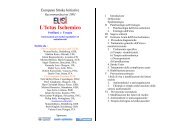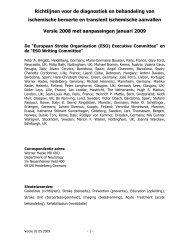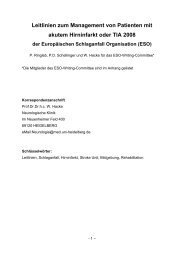Guidelines for Management of Ischaemic Stroke 2008 - ESO
Guidelines for Management of Ischaemic Stroke 2008 - ESO
Guidelines for Management of Ischaemic Stroke 2008 - ESO
You also want an ePaper? Increase the reach of your titles
YUMPU automatically turns print PDFs into web optimized ePapers that Google loves.
<strong>ESO</strong>-<strong>Guidelines</strong> <strong>for</strong> <strong>Management</strong> <strong>of</strong> <strong>Ischaemic</strong> <strong>Stroke</strong> <strong>2008</strong><br />
patients was not increased in those having cerebral microbleeds on pre-treatment<br />
T2*-weighted MRI [166].<br />
Vascular imaging should be per<strong>for</strong>med rapidly to identify patients with tight<br />
symptomatic arterial stenosis who could benefit from endarterectomy or angioplasty.<br />
Non-invasive imaging with colour-coded duplex imaging <strong>of</strong> the extracranial and<br />
intracranial arteries, CT angiography (CTA), or contrast-enhanced MR angiography<br />
(CE-MRA) is widely available. These approaches are relatively risk-free, whereas<br />
intra-arterial angiography has a 1-3% risk <strong>of</strong> causing stroke in patients with<br />
symptomatic carotid lesions [167, 168]. Digital subtraction angiography (DSA) may<br />
be needed in some circumstances, <strong>for</strong> example when other tests have been<br />
inconclusive.<br />
Carotid ultrasound, MRA and CTA visualise carotid stenosis. Systematic reviews and<br />
individual patient data meta-analysis indicate that contrast-enhanced MRA (CE-MRA)<br />
is the most sensitive and specific non-invasive imaging modality <strong>for</strong> carotid artery<br />
stenosis, closely followed by Doppler ultrasound and CTA, with non-contrast MRA<br />
being the least reliable [169, 170].<br />
Some data suggest that vertebrobasilar TIA and minor stroke is associated with a<br />
high risk <strong>of</strong> recurrent stroke [171]. Extracranial vertebral ultrasound diagnosis is<br />
useful, but intracranial ultrasound <strong>of</strong> the vertebrobasilar system can be misleading<br />
due to low specificity. Limited data suggest that contrast-enhanced MRA and CTA<br />
<strong>of</strong>fer better non-invasive imaging <strong>of</strong> the intracranial vertebral and basilar arteries<br />
[172].<br />
Unlike other imaging modalities ultrasound is fast, non-invasive and can be<br />
administered using portable machines. It is there<strong>for</strong>e applicable to patients unable to<br />
co-operate with MRA or CTA [157]. However, Doppler-studies alone <strong>of</strong>ten provide<br />
only limited in<strong>for</strong>mation, are investigator-dependant and require skilled operators,<br />
although they allow repeated measurements at the bedside.<br />
- 24 -





